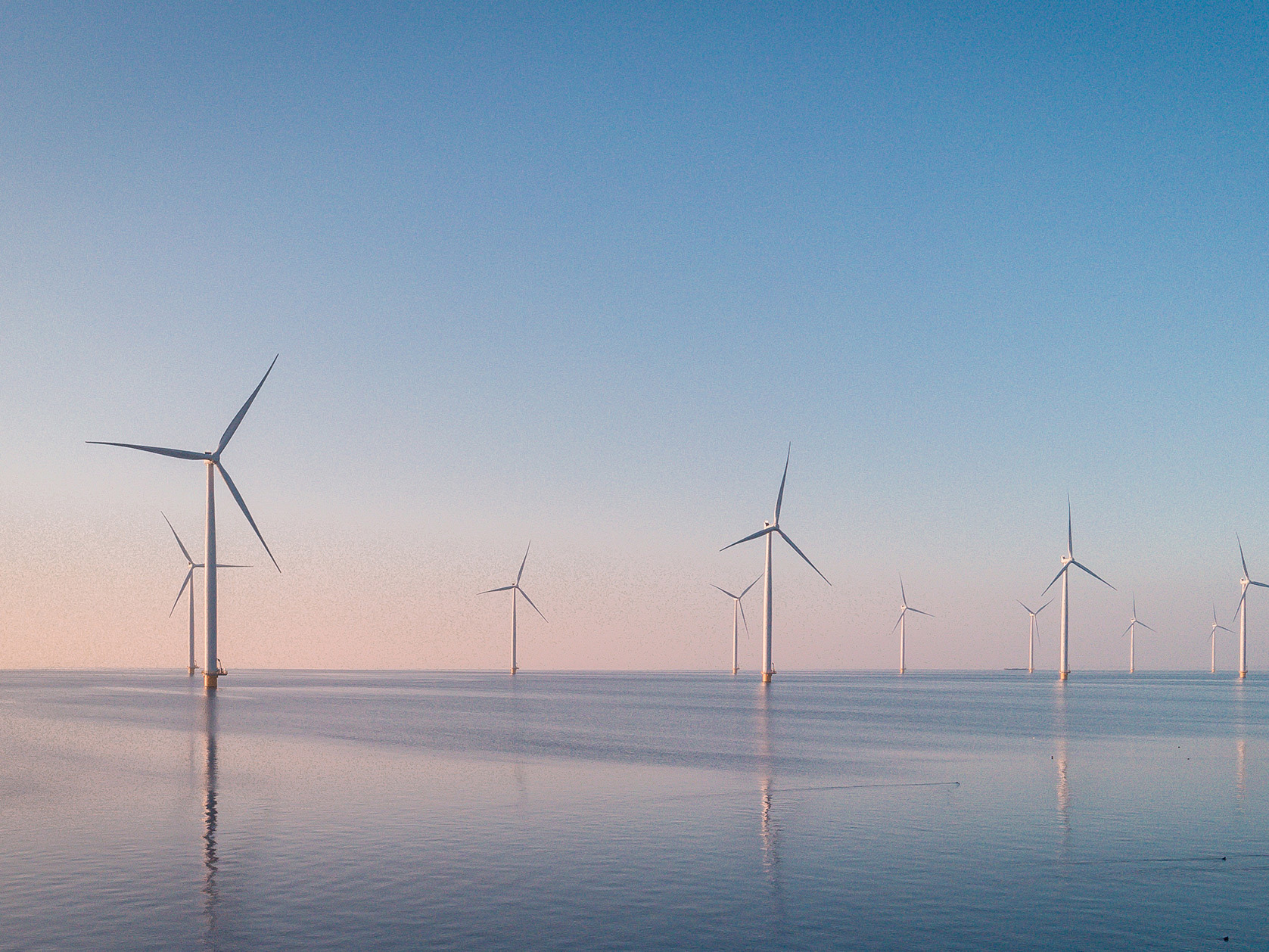Nathan Turner, Country Manager New Zealand at offshore wind developer, BlueFloat Energy, has a powerful vision for the role of offshore wind in New Zealand’s energy system in 2050. A clear and ambitious long-term strategy to maximise our renewable resources will have resulted in ~8 GW of built offshore wind capacity. Moreover, the offshore wind industry will have created positive economic impacts for New Zealand and grown alongside local communities, which will take pride in the projects built. Co-leaders of MinterEllisonRuddWatts’ energy team, Partner Scott Thompson and Senior Associate Natasha Hood sat down with Turner to zero in on the opportunities and challenges of offshore wind in New Zealand and how we might achieve his vision.
BlueFloat Energy (BlueFloat) is an international developer working on offshore wind energy projects in multiple locations around the world. Partnering with New Zealand based energy consultancy Elemental Group, BlueFloat has plans for wind farms off the South Auckland/Waikato and South Taranaki coasts. The South Taranaki project is designed to be an ~900 MW capacity, bottom-fixed [1] development. For Waikato, BlueFloat proposes an initial 810 MW of bottom-fixed technology in phase 1, followed by a further 1,125 MW of floating [2] technology in phase 2. These are significant projects. For context, the largest onshore wind farm currently operating in New Zealand is Mercury’s 222 MW capacity Turitea.
Why offshore wind developments matter to New Zealand
It is the scale of offshore wind farms that Turner believes will unlock both decarbonisation and economic benefits for New Zealand.
Electrification alone will not get New Zealand to net zero by 2050. A large part of our economy will need to be decarbonised via alternative fuels and technologies and, to do so, we will need to generate renewable energy at scale. Offshore wind farms can achieve that level of generation with less social, topographical, resource, and infrastructure limitations than onshore projects. For example, a 1 GW offshore wind development will require just one grid connection, one resource consent, and significantly less turbines compared to, say, five separate 200 MW onshore projects. Turner stresses that there is absolutely a need for onshore renewable generation, but alongside offshore projects of scale.
Offshore wind developments will also help create conditions in our energy system to promote broader business investment in New Zealand. Unless we can meet the energy trilemma objectives – reliability, affordability, and sustainability – Turner believes an exodus of business is a real risk. Current pressures on industry from high wholesale electricity prices are a case in point. Not only will an abundance of renewable electricity help with affordability, but the high capacity factors [3] of offshore wind farms will provide reliability. The ability to connect close to load centres will also reduce pressure on the broader system.
Turner also sees a real economic opportunity from decarbonising our existing economy and then encouraging international, energy-intensive businesses to set up shop in New Zealand. In this way our renewable energy can be used to grow our economy by powering new businesses, such as data centres.

In a world where we’re trying to grow our economy to lift our standard of living, we need to be thinking about our competitive advantages as a country. Our renewable resources are absolutely one of those.
Enabling offshore wind development
Having completed two years of desktop evaluation, BlueFloat is ready and waiting on the Government for the opportunity to conduct site investigation work.
The Government has made key decisions around the design of an offshore renewable energy regulatory regime [4] and intends to have legislation in place by mid-2025. The regime introduces two dedicated offshore renewable energy permits: seven-year feasibility permits to enable feasibility studies in a specific area and commercial permits to enable construction and operation for up to 40 years. The aim is to open a first feasibility permit round in late 2025 with first feasibility permits granted in 2026 [5].
What else does New Zealand need to be doing now to enable offshore wind development?
From a broader energy system perspective, Turner is concerned there are ongoing disincentives to investment in renewables in New Zealand relating to demand and offtake arrangements. Changes in climate change and energy policy create significant uncertainty about demand growth, which in turn affects the speed at which developments need to come to market. Like others in the industry [6], Turner calls for a greater degree of consensus between our major political parties on long-term policies. He also believes New Zealand would benefit from some level of government coordination and planning on offtake arrangements to unlock private capital. Renewable energy projects will lag if developers are reliant solely on a corporate power purchase agreement (PPA) market.
More can be done to prepare specifically for offshore wind in New Zealand. Turner points, for example, to the Victorian Government’s coordinated approach to developing the industry. It has set specific renewable energy targets and published a series of implementation statements to support and guide industry, stakeholders, and community [7]. The statements cover matters such as procurement approach, legislative and regulatory reform, supply chain, local industry (including training), infrastructure and environmental and cultural aspects. BlueFloat is working with the existing local supply chain to find a role for New Zealand companies in the development and operation phases of its projects. However, Turner would like to see a workforce strategy designed to deliver on the Government’s Electrify New Zealand policy.
Policy aside, New Zealand will need grid and port infrastructure upgrades to enable offshore wind generation. The need for grid upgrades is not specific to offshore wind. Turner encourages strategic, proactive grid upgrades to avoid transmission becoming a bottleneck. We will need to start strengthening and expanding some of our existing ports to handle the sort of componentry – a single offshore wind blade is 120m long – that will be coming into the country. BlueFloat and the other offshore wind developers in New Zealand are working collaboratively on what the industry will need to avoid redundant infrastructure.
It is important that New Zealand continues to move at pace to take advantage of a likely APAC offshore wind cluster of expertise. Australia, for example, has already awarded 13 feasibility licenses for offshore wind projects. Those projects will be two to three years ahead of equivalent developments here. By the time New Zealand’s first offshore wind farms will be built, there is likely to be a construction and installation supply chain, installation vessels, ecological expertise, and contractor workforce. There will also be more offshore wind farm financing experience in the region.
Offshore wind in 2050
Turner sees 8 GW of offshore wind – the mid case “electrification plus” scenario in PwC’s recent National Impact Study: New Zealand Offshore Wind Industry – as an “optimistic but realistic” target for New Zealand in 2050. More than that, Turner hopes: "We would have done it in a way that’s had a really positive impact for New Zealand in the sense that we will have created a pipeline of projects with certainty that has allowed the supply chain to invest in local fabrication and local participation in projects. So, the broader economic trickle-down effects have been far greater than just the sheer power generated…and the projects will be a source of pride because they have been delivered in the right way and people can see the benefits from them."
What will it take to achieve Turner’s vision? He urges New Zealand to consider what we want to be, as a country, in 2050. We have the opportunity to use our renewable resources to build our economy to our competitive advantage. If we take that kind of vision, then offshore wind will follow naturally.
Footnotes
1. Turbines are mounted on top of structures which are embedded into the seabed.
2. Turbines are mounted on top of floating foundations anchored to the seabed by mooring lines.
3. The capacity factor is the ratio between what a generation unit can generate at maximum output versus the unit’s actual generation output over a period of time.
4. The regime covers all forms of offshore renewable energy development.
5. Offshore renewable energy | Ministry of Business, Innovation & Employment (mbie.govt.nz).
6. Industry Association letter on cross-party consensus (ena.org.nz).
7. See Offshore wind energy.









